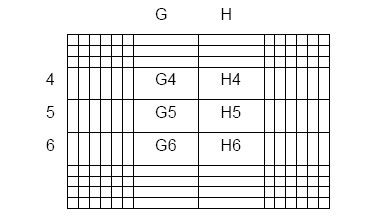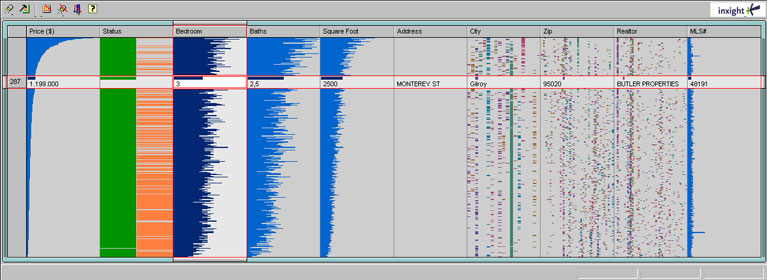Teaching:TUW - UE InfoVis WS 2006/07 - Gruppe 02 - Aufgabe 1 - Table Lens
Quotations[edit]
Table Lens Focus+Context Technique[edit]
Focus+Context techniques support visualizing an entire information structure at once as well as zooming in on specific items. [Rao and Card, 1994] The zooming-ability allows the display of large amounts of tabular data in a very lucid way.
Table Lens Focal Technique[edit]
The predominant method in displaying tabular data is using the structured view of a spreadsheet respectively a table. Spreadsheets focus on all datasets appropriately. When the data sets become too large to be displayed in a proper way some other visualisation technique must be found. A Table Lens focuses only on some datasets.
The graph shows a 10 by 14 table with a focal area of 3 by 2 cells. Cells in the focal area and the table row and column divide the total focus space of each dimension appropriately. [Rao and Card, 1994]
The Distortion[edit]
Cells are allocated spaces along each dimension independently, there is an interaction in cell geometry. Four types of cell regions are created by the disortion on the two axis: focal, row focal, column focal and nonfocal. [Rao and Card, 1994]
Focal cells are in the focus area along both axes , row focal and column focal are both half focal in that they are in the focal area of only one of the two axes, and nonfocal are in the context area along both axes. [Rao and Card, 1994]
Due to the fact that rows and columns outside the focal area - the context area - aren´t bent by the warping they can be scanned by a single horizontal or vertical eye movement. This also enables label display, multiple focal areas and multiple focal levels.
To have several focal areas is important for comparing groups of datasets against each other.
Example[edit]
The following images were taken from a Table Lens Visualisation demo of collected data of the housing market in Santa Clara, California USA in January 2001. The application shown is the single available software application using this patented Table Lens technique - Inxight Table Lens™.
A total of 1548 datasets are displayed that can be grouped and sorted arbitrarily.
On the first image a single focal area is selected. This single selected dataset is equivalent to one house. The datasets are sorted by the first colum - the prize of the compared houses.
The second image shows three selected focal areas still sorted by their prizes.
The third image shows the very same selected datasets as in image 2 - now sorted by the column square foot.
See also[edit]
References[edit]
- Proceedings
[Tenev and Rao, 1997] T. Tenev, R. Rao, "Managing multiple focal levels in Table Lens," infovis, p. 59, 1997 IEEE Symposium on Information Visualization (InfoVis '97), 1997
[Rao and Card, 1994] R. Rao, S.K. Card. The Table Lens: Merging Graphical and Symbolic Representations in an Interactive Focus+Context Visualization for Tabular Information. In Proceedings of the ACM SIGCHI Conference on Human Factors in Computing Systems. ACM, April 1994. Retrieved at: October 29, 2006. http://www.ramanarao.com/papers/tablelens-chi94.pdf
- Web Links



